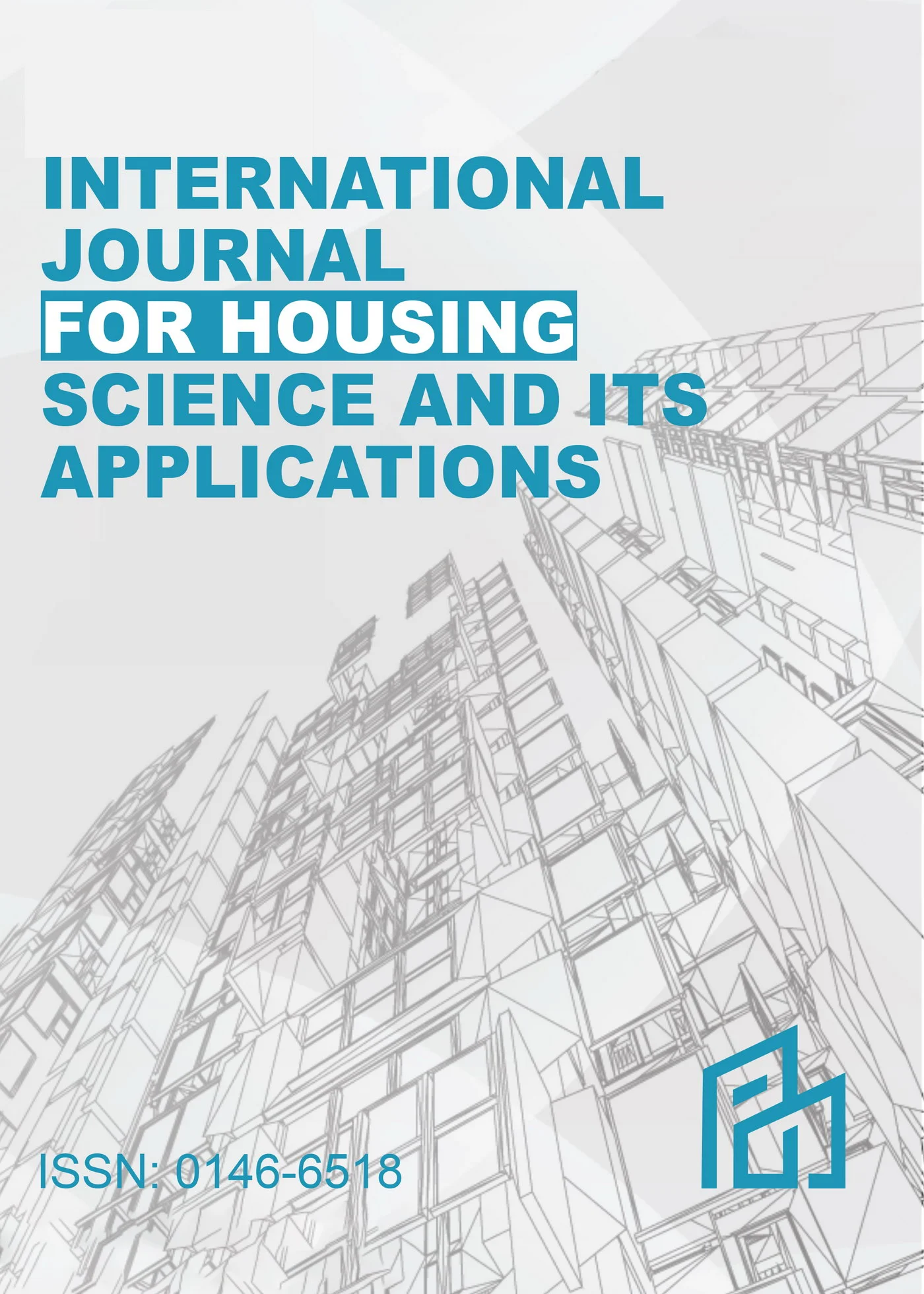International Journal for Housing Science and Its Applications
The International Journal for Housing Science and Its Applications (ISSN 0146-6518) is a prestigious, single-blind peer-reviewed international journal dedicated to advancing research in various fields, including Housing Science, Business, Management, Accounting, Marketing, Architecture, Building and Construction, and Mechanical Engineering. In addition to these core areas, the journal is open to publishing selected high-quality papers that explore the intersection of computer science and modern languages with the goal of enhancing human living standards. The journal publishes one volume each year, consisting of four issues released in March, June, September, and December, ensuring a steady flow of valuable insights and contributions to the academic community.
Founder

Professor Oktay Ural (Late)
Florida International University Miami, Florida , USA
Recently Published Articles
- Research article
- DOI: https://doi.org/10.70517/ijhsa464718
- Open Access
- Volume 46, Issue 4
- Pages: 8443
- -8454
- 10/08/2025
This paper establishes a “one-stop” student community party building system for universities based on field theory. From the perspective of technological empowerment in field theory, this paper utilizes big data technology to establish a party building digital profile and employment support system architecture, pushing personalized job opportunities to guide students in their employment. The paper selects employment data of college students from a certain university from 2016 to 2025 as the research sample to explore the reliability of the system and algorithm proposed in this paper. Research findings indicate that the employment support system can visually present specific student employment status through charts. Functional testing demonstrates that the system effectively enhances the efficiency of employment management operations. Comparisons between the employment recommendation results of this algorithm and traditional recommendation algorithms reveal higher predictive accuracy.
- Research article
- DOI: https://doi.org/10.70517/ijhsa464717
- Open Access
- Volume 46, Issue 4
- Pages: 8426
- -8442
- 10/08/2025
To predict cybersecurity incidents in an IoT environment, transform passive defense into “active” defense, and minimize potential damage to network systems, cybersecurity situational awareness technology has been rapidly developing. This paper integrates common methods for multi-source data fusion, applies an adaptive neural fuzzy inference system to assess cybersecurity situational awareness, and proposes an improved LSTM cybersecurity situational awareness prediction model based on the Sparrow Search Algorithm, achieving cybersecurity protection under multimedia fusion technology. Experimental results show that by quantitatively calculating cybersecurity posture values at different levels—service level, host level, and network system level— this assessment model provides more comprehensive assessment information compared to traditional methods, with more accurate results. Additionally, the average relative error of the improved SSA-LSTM neural network cybersecurity posture prediction algorithm stabilizes around 5.29%, enabling effective prediction of cybersecurity posture over the coming period.
- Research article
- DOI: https://doi.org/10.70517/ijhsa464716
- Open Access
- Volume 46, Issue 4
- Pages: 8413
- -8425
- 10/08/2025
To assist enterprises in making personalized financial decisions, this paper designs a big data-based financial decision support platform based on the design concept of “data processing-data analysis-data presentation-data decision-making,” providing a decision support environment for financial decision-makers. To optimize personalized financial decisions, a random forest algorithm is used to construct an enterprise financial data risk warning model. Sample data and financial risk warning indicators are selected, and the random forest algorithm is used to estimate feature importance. The confusion matrix is employed as the metric standard for financial warning results. The hyperparameters of the random forest model are optimized, including n-tree optimization and mtry selection. Financial indicator data from T-1 year, T-2 year, and T-3 year are extracted separately for risk prediction analysis, and corresponding random forest classification models are constructed based on this. Compare the financial risk prediction accuracy rates of each model to validate the feasibility of the random forest algorithm as a key technology for a big data financial decision support platform. For T-1 year data, the enterprise financial data risk warning model based on the random forest algorithm demonstrates the best predictive performance, with accuracy and recall rates both exceeding 90%, with accuracy as high as 97%.
- Research article
- DOI: https://doi.org/10.70517/ijhsa464715
- Open Access
- Volume 46, Issue 4
- Pages: 8397
- -8412
- 10/08/2025
Traditional concrete currently struggles to meet the demands of the construction industry. To address this issue, oil palm shell aggregate green concrete has been developed. Raw materials for preparing oil palm shell aggregate green concrete were selected, and under the guidance of appropriate material mix ratios and preparation processes, five different samples of oil palm shell aggregate green concrete were ultimately produced. The DEGWO combined optimization algorithm was used to optimize the least squares support vector regression model, resulting in a DE-GWO-LSSVR-based performance prediction model for oil palm shell aggregate green concrete. This model was then applied to conduct predictive empirical analysis of the performance characteristics of oil palm shell aggregate green concrete. The predictive empirical analysis revealed that the actual compressive strength test values of the 14-day samples were distributed within the range of [60.42 MPa, 62.72 MPa], with an error of less than 1 MPa compared to the target results [60.36 MPa, 63.33 MPa], which is within an acceptable range. This demonstrates the application value of the DE-GWO-LSSVR model in oil palm shell aggregate green concrete.
- Research article
- DOI: https://doi.org/10.70517/ijhsa464714
- Open Access
- Volume 46, Issue 4
- Pages: 8383
- -8396
- 10/08/2025
Electricity user behavior data is complex and diverse, resulting in significant variability and uncertainty in user behavior data, which increases the difficulty of monitoring electricity user behavior and leads to low monitoring rates. This paper utilizes the singular value equivalent matrix to obtain a non-Hermitian matrix and performs standardization processing on the aforementioned matrix. Considering the ARMA equation system for time series stationarity, the proposed numerical solution is used to calculate the expression, thereby extending RMT from a purely Gaussian environment to a non-Gaussian environment. An ETD-SAC electricity theft detection model framework is constructed to determine whether users are engaging in electricity theft during the detection period. Through user electricity consumption behavior detection, it was found that the electricity load trend of electricity theft users fluctuated between [8.54, 38.54] kWh after July 15, 2023. One of the suspected users detected bypassed the meter for electricity theft, with the meter current ranging from -0.1 to 0.4 A, while the actual incoming current was 0.6 to 1 A, constituting electricity theft behavior. Using the same method for electricity theft behavior analysis, CZ Factory was found to have engaged in electricity theft on October 1, 2023, requiring the recovery of 1,354 units of electricity and 1,126.528 yuan in electricity fees. The anti-electricity theft application model based on ARMA achieved good results.
- Research article
- DOI: https://doi.org/10.70517/ijhsa464713
- Open Access
- Volume 46, Issue 4
- Pages: 8370
- -8382
- 10/08/2025
The increasing depth of the industry-education synergy model in college education provides diverse development possibilities for college students’ innovation and entrepreneurship education work. This paper combines the work of innovation and entrepreneurship education in colleges and universities, and briefly analyzes its realization methods in the framework of industry-teaching integration. At the same time, from the perspective of the recipients, it initially constructs the evaluation index system of innovation and entrepreneurship education. In order to more accurately assess the results of innovation and entrepreneurship education in colleges and universities, this paper chooses the Extreme Learning Machine (ELM) algorithm as the identification algorithm. Because the prediction accuracy of ELM algorithm is low, the cuckoo search (CS) algorithm is used to improve it, so as to form CS-ELM algorithm. On this basis, the number of neurons in each layer, the learning rate and the training function are determined separately to design a set of innovative entrepreneurship education evaluation model. In the simulation experiment of this model, the comprehensive output value of University V is 0.7281. It shows that the current innovation and entrepreneurship education of University V is better as a whole, and further improvement can still be made.
- Research article
- DOI: https://doi.org/10.70517/ijhsa464712
- Open Access
- Volume 46, Issue 4
- Pages: 8351
- -8369
- 10/08/2025
The rapid development of artificial intelligence and UAV technology is driving the application of police UAV clusters in the fields of social governance and public safety. The article optimizes the coherent formation control of police UAV clusters based on the artificial intelligence algorithm of particle swarm. Its dynamics model is optimized according to the flight characteristics of quadrotor UAVs, and the convergence speed is further improved by the particle swarm algorithm. Introducing rounded variables in the discrete-time control barrier function makes the UAV more natural in the obstacle avoidance process. The range of the Liapunov function is adaptively adjusted to improve the success rate of intersection construction. Meanwhile, the event triggering strategy is introduced to solve the optimal control variables for obstacle avoidance. The coherent formation control algorithm in this paper can complete the UAV converging to the reference trajectory along the X-axis and Y-axis within 0.5 seconds. The clustering success rate of the event-triggered obstacle avoidance strategy is improved by 5.84% to 18.95% compared with the comparison algorithm. The police UAV using the cooperative control method in this paper monitors that the PM2.5 concentration on urban roads is significantly reduced after water sprinkling. For a comprehensive evaluation result of water quality in a watershed is 0.139, which belongs to class II water quality. The UAV cluster can be linked with the city management system to build an all-round and three-dimensional governance system.
- Research article
- DOI: https://doi.org/10.70517/ijhsa464711
- Open Access
- Volume 46, Issue 4
- Pages: 8341
- -8350
- 10/08/2025
Taking employees of service-oriented enterprises as the research object, this study explores the influence of emotion management ability on task completion efficiency through hierarchical regression modeling. Based on the data of 406 valid questionnaires, the four-dimensional structure of emotion management (emotion awareness, emotion expression, emotion adjustment, emotion utilization) and the dual connotation of task efficiency (task performance, relationship performance) were constructed. The empirical analysis showed that the reliability of the emotion management scale was good, with an overall Cronbach’s α = 0.822 and a factor cumulative variance explained of 65.38%. The Emotion Expression dimension scored the highest with a mean value of 4.32, and the Emotion Awareness dimension scored the lowest with 3.68. Pearson correlation analysis showed significant positive correlations among the four dimensions of Emotion Management, r=0.602~0.776, and significant positive correlations were found with Task Performance r=0.617~0.774, Interpersonal Facilitation r=0.586~0.702, and Work Devotion r=0.634~0.746, which were all significantly positive. 0.746 were all significantly positively correlated. The hierarchical regression model further verified that emotional awareness β=0.274, emotional adjustment β=0.284 and emotional use β=0.263 had significant positive predictive effects on task performance (p<0.001), and the model as a whole did not have the problem of multiple covariance VIF<1.2. The results of the study provide data support for service-oriented enterprises to optimize the training of employees' emotional management and to improve the efficiency of tasks.
- Research article
- DOI: https://doi.org/10.70517/ijhsa464710b
- Open Access
- Volume 46, Issue 4
- Pages: 8335
- -8340
- 10/08/2025
Landscape data were interpreted from Landsat MSS and TM satellite imagery, DEM data, and average grain yield records of the Lishui River watershed for the years 1980, 2000, and 2010. Using ENVI 4.7, ArcGIS 9.0, and Fragstats 3.3 software, landscape type maps for the Li River region in 1980, 2000, and 2010 were extracted, and the ecosystem service values for each landscape type were calculated for these three periods. The results show that between 1980 and 2010, the significant reduction in paddy field and woodland areas led to a continuous decline in ecosystem service value. Over the decade following 2000, the rate of decline was faster than in the previous twenty years. This trend poses serious resource and environmental challenges for the Lishui River watershed, including overharvesting of commercial timber, increased endangered species risk, degradation of aquatic vegetation, water pollution, and other ecological problems. To address these issues, it is necessary to strengthen policy support, establish sound legal frameworks, and implement strict management measures. Strategies should include developing eco-tourism to promote local economic growth, protecting biodiversity in key areas, conserving critical species resources, enhancing wetland and forest protection, and cultivating crops with lower water demand and higher water conservation capacity. These measures will help promote the sustainable economic, social, and ecological protection of the Lishui River watershed.
- Research article
- DOI: https://doi.org/10.70517/ijhsa464710a
- Open Access
- Volume 46, Issue 4
- Pages: 8323
- -8334
- 10/08/2025
In the era of big data, the modernization of national governance systems and capabilities requires a transformation of governance concepts and the optimization of governance mechanisms. It also calls for the full utilization of the Internet, big data, and artificial intelligence to establish and refine supervisory and management methods and rules, ultimately achieving precision and intelligence in administration. Environmental monitoring serves as a critical foundation for China’s environmental governance and decision-making. With the formal integration of ecological civilization into China’s “five-in-one” overall framework, and as environmental issues become increasingly prominent, leveraging big data to enhance ecological and environmental monitoring through intelligent means has become a key initiative in government-led environmental governance. It is also a prerequisite for ensuring that environmental actors fulfill their obligations and assume legal responsibility under the law. This approach is effective in enhancing the standardization, precision, and scientific underpinnings of China’s environmental governance. This study explores how the integration of big data is driving profound changes in governance concepts and practices within the ecological and environmental monitoring system. It also analyzes challenges in China’s current ecological and environmental regulatory system, including inadequate and fragmented environmental monitoring legislation, the absence of a well-established data-sharing mechanism, incomplete platform construction, and insufficient management of socialized environmental monitoring institutions. Finally, the study proposes recommendations to strengthen legislation on ecological and environmental monitoring and data, improve the legal framework for data sharing, enhance the development of environmental information and data platforms, and refine the management system for socialized environmental monitoring institutions.
- Research article
- DOI: https://doi.org/10.70517/ijhsa464710
- Open Access
- Volume 46, Issue 4
- Pages: 8313
- -8322
- 10/08/2025
From the perspective of the development trend of school sports in the new era, relying only on the school to increase the time of physical activity has obviously failed to meet the students’ daily demand for physical activity, and how to effectively integrate the physical education resources inside and outside the classroom to jointly promote the healthy development of the students’ body is particularly important. In this paper, for the problems existing in the integration of physical education teaching resources in private colleges and universities in Wuhan, we put forward a model of physical education teaching resources integration based on cloud computing, construct a multitasking self-coder, adopt fuzzy clustering algorithm to classify the teaching resources, and build a specialized coding unit for the teaching content and physical education teaching course resources. The experimental results show that the introduction of fuzzy clustering algorithm to classify resource categories can save 5-10s of time and can speed up the clustering speed of resource integration, and the designed information integration system of physical education learning resources has a very good ability to integrate the information of teaching resources, with a high recall rate of the resource information and a low redundancy of the information, which is of great significance to enhance the teaching effect of the physical education teaching courses.
- Research article
- DOI: https://doi.org/10.70517/ijhsa464709
- Open Access
- Volume 46, Issue 4
- Pages: 8303
- -8312
- 10/08/2025
In the current digital business environment, the importance of optimizing corporate tax incentives is becoming increasingly important. Based on the theory related to tax burden, this paper adopts genetic algorithm to optimize different tax incentives, and in the process of searching uses the principle of survival of the fittest of the theory of evolution to find the optimal solution, and then obtains a strategy to minimize the tax burden of enterprises. This paper uses a production enterprise as the object of study for specific case study, to obtain a more intuitive research effect, the results show that K, L, M and N four kinds of programs, which can take into account the three single policy objectives determined by the overall goal of the tax incentives. The optimal solution for the “three and two” type of VAT rate simplification and reform party is N. A production enterprise obtains more cash flow through tax planning, which can create more value, and verifies the effectiveness of the genetic algorithm model from the side.


